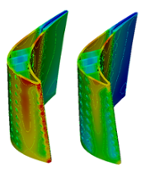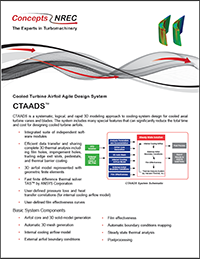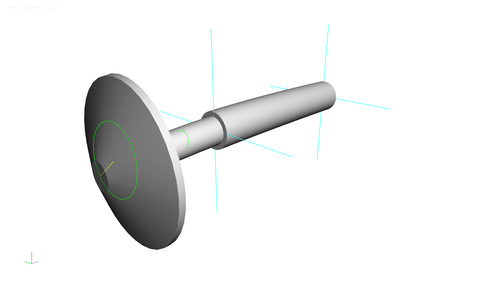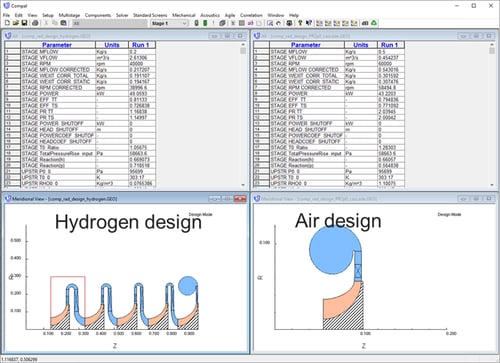CTAADS™
CAE Software for Blade Cooling
The Cooled Turbine Airfoil Agile Design System (CTAADS) provides a systematic and rapid 3D modeling approach to cooling-system design for cooled axial turbine vanes and blades. The system includes many special features that can significantly reduce the total time and cost to generate airfoil cooling-passage geometry and perform a complete 3D thermal analysis.

Software Highlights - Aero Load Mapping
-
-
Integrated suite of independent software modules
-
Efficient data transfer and sharing
-
Complete 3D thermal analysis including film holes, impingement holes, trailing edge exit slots, pedestals, and thermal barrier coating
-
3D airfoil model represented with geometric finite elements
-
Fast finite difference thermal solver
-
User-defined pressure loss and heat-transfer correlations (for internal cooling airflow model)
-
User-defined film effectiveness curves
-
-
-
Airfoil core and 3D solid-model generation
-
Automatic 3D mesh generation
-
Internal cooling airflow model
-
External airfoil boundary conditions
-
Film effectiveness
-
Automatic boundary conditions mapping
-
Steady-state thermal analysis
-
Post processing
-
-
Integrated suite of independent software modules
-
Efficient data transfer and sharing
-
Complete 3D thermal analysis including film holes, impingement holes, trailing edge exit slots, pedestals, and thermal barrier coating
-
3D airfoil model represented with geometric finite elements
-
Fast finite difference thermal solver
-
User-defined pressure loss and heat-transfer correlations (for internal cooling airflow model)
-
User-defined film effectiveness curves
-
Airfoil core and 3D solid-model generation
-
Automatic 3D mesh generation
-
Internal cooling airflow model
-
External airfoil boundary conditions
-
Film effectiveness
-
Automatic boundary conditions mapping
-
Steady-state thermal analysis
-
Post processing

- Integrated suite of independent software modules
- Efficient data transfer and sharing
- Complete 3D thermal analysis including film holes, impingement holes, trailing edge exit slots, pedestals, and thermal barrier coating
- 3D airfoil model represented with geometric finite elements
- Fast finite difference thermal solver
- User-defined pressure loss and heat-transfer correlations (for internal cooling airflow model)
- User-defined film effectiveness curves
Basic System Components
- Airfoil core and 3D solid-model generation
- Automatic 3D mesh generation
- Internal cooling airflow model
- External airfoil boundary conditions
- Film effectiveness
- Automatic boundary conditions mapping
- Steady-state thermal analysis
- Post processing
Feature Highlights
-
Integrated suite of independent software modules
-
Efficient data transfer and sharing
-
Complete 3D thermal analysis including film holes, impingement holes, trailing edge exit slots, pedestals, and thermal barrier coating
-
3D airfoil model represented with geometric finite elements
-
Fast finite difference thermal solver
-
User-defined pressure loss and heat-transfer correlations (for internal cooling airflow model)
-
User-defined film effectiveness curves
Basic System Components
-
Airfoil core and 3D solid-model generation
-
Automatic 3D mesh generation
-
Internal cooling airflow model
-
External airfoil boundary conditions
-
Film effectiveness
-
Automatic boundary conditions mapping
-
Steady-state thermal analysis
-
Post processing
Product Support

Customer-driven Improvement

Technical Support

Documentation
CTAADS Brochure
CTAADS is CAE software with a systematic and rapid 3D modeling approach to turbine blade cooling methods for cooled axial turbine vanes and blades.

Find Your Rep
Our Sales Offices are strategically located around the globe to service all your turbomachinery needs.
Corporate Headquarters
217 Billings Farm Road
White River Junction, VT 05001-9486
Phone: 802-296-2321
Fax: 802-296-2325
Email: sales@conceptsnrec.com
North America Software Sales
Phone: 802-280-6181
Fax: 802-296-2325
Email: droberson@conceptsnrec.com
Upcoming Events
Tradeshows, Workshops, Webinars and more.
2021 Online Centrifugal and Axial Pumps Course - Modern Design, Performance, and Problem Solving
Application-Based Learning
Date: October 18 - 29, 2021
Time: 9:30 am - 1:00 pm EDT
Course Fee: $3500 USD
This course is designed to help engineers design, test, and run pumps and systems that are more efficient, more economical, and more reliable. Engineers will come to understand the best state-of-the-art design practices and learn the latest theories on performance, cavitation, dynamic forces, and noise. The course will review the latest advances in design tools and will provide expert and relevant instruction to designers on pump design optimization. Nearly half of all the teaching is focused on actual commercial design cases with measured data for confirmation.
2021 Trade Show: ComVac Asia
Visit Concepts NREC China at the ComVac Asia
Date: October 26-29, 2021
Location: Shanghai, China
To learn more, visit https://www.comvac-asia.com/index.php?lang=en
I came to the realization that we needed some objective insight.
We were working well with the OEM but even with our combined efforts, we were struggling to get a critical compressor to pass performance on their test stand. Although I'd never directly done business with Concepts NREC I was familiar with them and their capability so I chose to contact them when I came to the realization that we needed some objective insight. Concepts NREC fielded my cold call and immediately engaged their expertise in a complex problem that was also challenged by schedule constraints. They provided increased understanding of an already complex CFD which resulted in increased confidence that the proposed solution would succeed on the next test stand attempt (which it did!). We are pleased to have had the help of Concepts NREC and now have a well-performing compressor in our process.”
Bryan Barrington
Senior Advisor - Machinery Engineering




